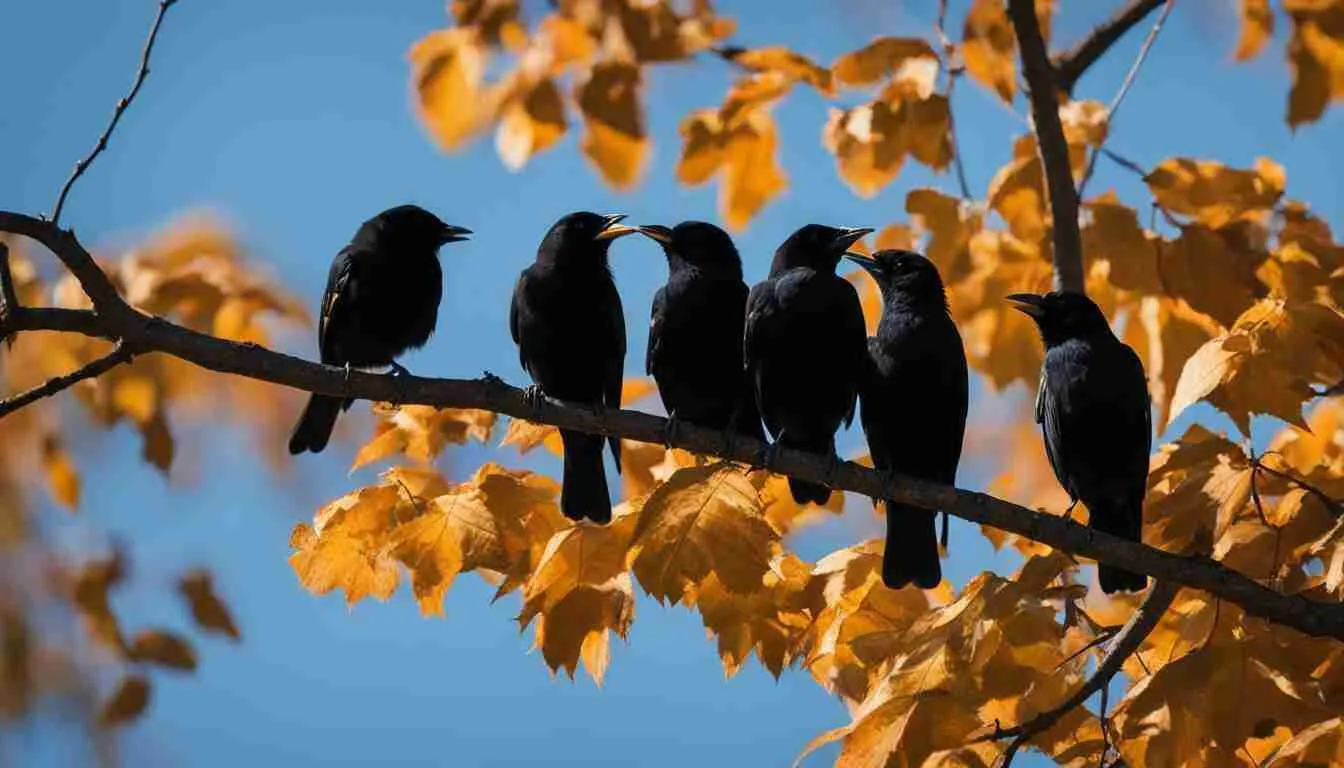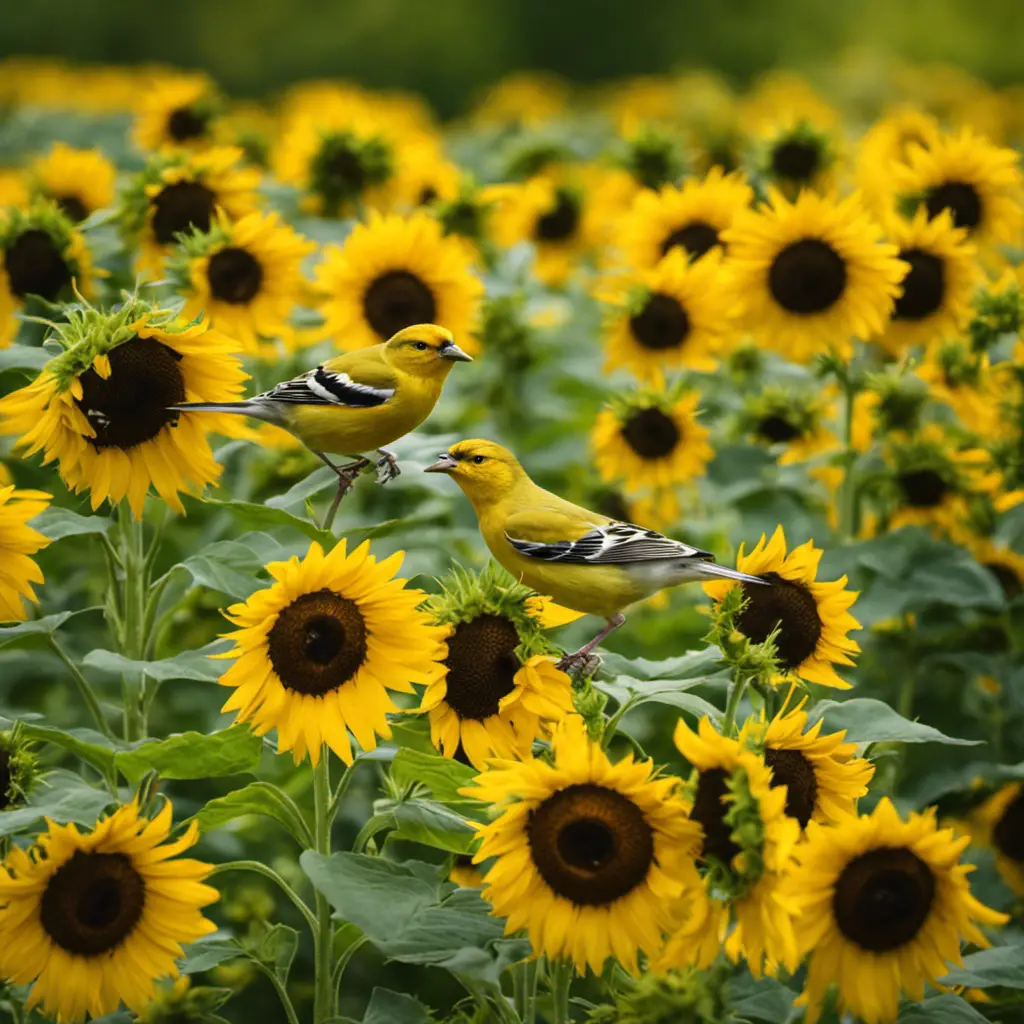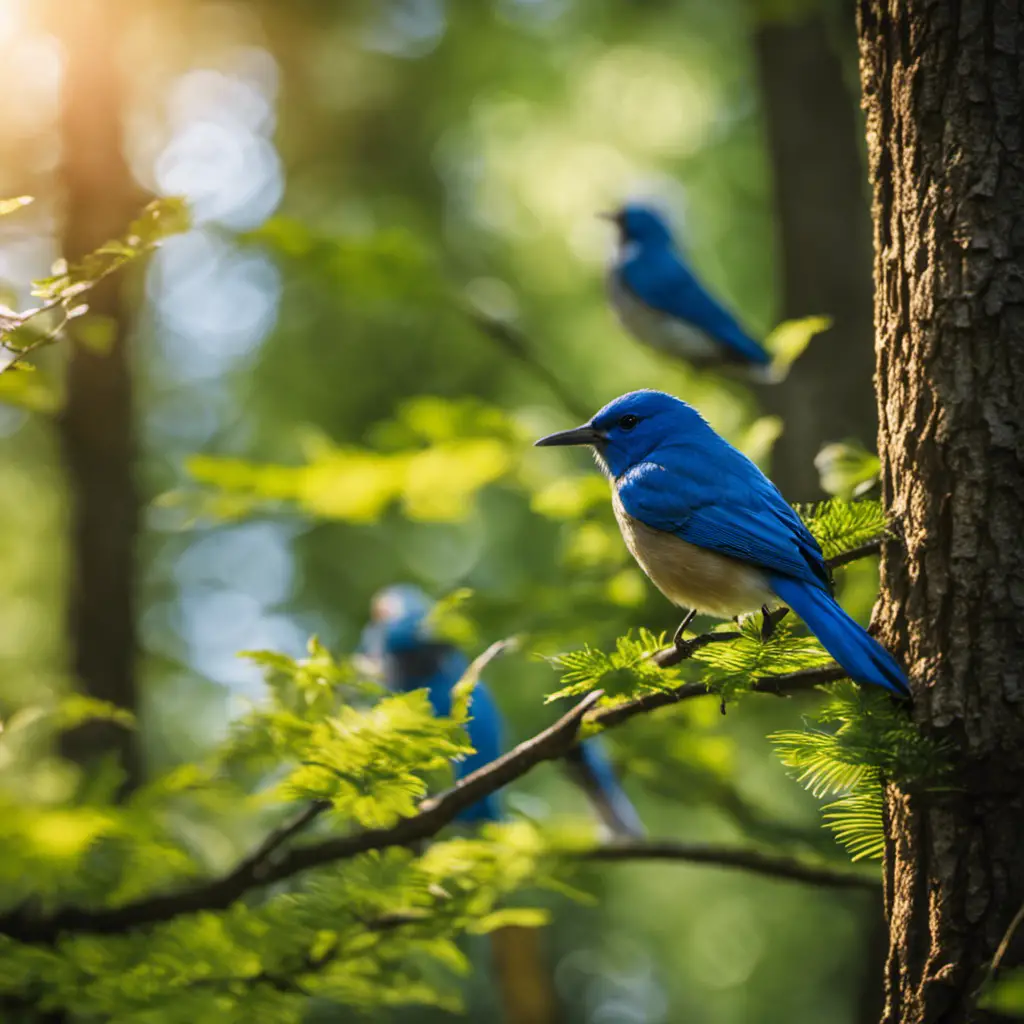If you’re a bird enthusiast in Michigan, you’ll be delighted to know that the state is home to a vibrant array of red birds.
The American Robin, Northern Cardinal, Purple Finch, House Finch, Common Redpoll, Red Phalarope, Red-billed Tropicbird, Red-footed Booby, and Reddish Egret can all be spotted here.
These fascinating creatures, with their striking red plumage, add a splash of color to Michigan’s natural landscapes.
Get ready to explore the diverse and captivating world of red birds in this article.
Key Takeaways
- There are several species of red birds in Michigan, including the American Robin, Northern Cardinal, Purple Finch, House Finch, and Common Redpoll.
- Woodpeckers, such as the Red-headed Woodpecker and Red-bellied Woodpecker, are also considered red birds in Michigan.
- Hawks, including the Red-tailed Hawk and Red-shouldered Hawk, can also be found in Michigan and are known for their red plumage.
- The Red-breasted Nuthatch is another red bird species that can be found in Michigan.
American Robin
You should take a closer look at those American robins in your backyard. The American robin, scientifically known as Turdus migratorius, is a migratory songbird native to North America.
During the breeding season, these birds exhibit interesting behaviors. American robins are known for their distinctive orange-red breast, grayish-brown upperparts, and a white eye-ring. Males and females look similar, but males tend to be more vibrant in color. American robins are monogamous and form pairs during the breeding season.
They build cup-shaped nests made of grass, twigs, and mud, usually in trees or shrubs. The female lays a clutch of three to five blue eggs, which she incubates for about two weeks. After hatching, both parents take turns feeding the chicks a diet consisting mainly of earthworms and insects.
As for their migration patterns, American robins are known to breed in North America and migrate south during the winter months. They can often be seen in large flocks feeding on berries and fruits.
Northern Cardinal
When you see a flash of red in your backyard, it’s likely that a Northern Cardinal has arrived. These beautiful birds, with their vibrant red plumage and distinctive crest, are a common sight in North America.
If you’re interested in bird watching and want to attract Northern Cardinals to your yard, here are a few tips:
Provide food: Cardinals enjoy seeds, especially sunflower seeds and safflower seeds. Make sure to have a bird feeder filled with these seeds to attract them.
Create a suitable habitat: Cardinals prefer areas with dense shrubs and trees for nesting and protection. Planting bushes and trees in your yard can create an inviting environment for these birds.
Offer fresh water: Cardinals need water for drinking and bathing. Adding a bird bath or small pond to your yard can attract them.
Preserve their habitat: Conserving natural areas and preventing habitat destruction is crucial for the long-term survival of Northern Cardinals.
Purple Finch
Have you ever seen a Purple Finch perched on a tree branch in your backyard? These small, colorful birds play a crucial role in the ecosystem of Michigan. Purple finches are known for their vibrant plumage, with the males displaying a rich reddish-purple hue and the females a more subdued brown color. They are primarily seed-eaters, feeding on a variety of seeds from trees such as spruce, pine, and birch. This makes them important dispersers of seeds, aiding in the regeneration of forests. Michigan is a key stopover site for purple finches during their migration. They typically breed in the boreal forests of Canada and Alaska and migrate south to the United States during the winter months. The table below summarizes the migration patterns of purple finches in Michigan:
| Season | Location | Behavior |
|---|---|---|
| Spring | Northern | Breeding |
| Michigan | ||
| ———— | —————- | ————– |
| Fall | Southern | Migrating |
| Michigan | ||
| ———— | —————- | ————– |
| Winter | Throughout | Overwintering |
| Michigan |
Understanding the role and migration patterns of purple finches is important for conservation efforts and maintaining a healthy ecosystem in Michigan.
House Finch
The vibrant plumage of the House Finch adds a pop of color to your backyard, enhancing the beauty of your surroundings.
This small bird, scientifically known as Haemorhous mexicanus, is commonly found in North America. The House Finch is adaptable and can be found in a variety of habitats, including urban areas, woodlands, and grasslands.
It’s a social bird, often seen in flocks, and is known for its melodious song. The diet of the House Finch consists mainly of seeds, including those from grasses, weeds, and trees. They’re also known to consume fruits and insects on occasion.
These adaptable birds have successfully made their homes in residential areas and continue to be a delightful sight for bird-watchers.
Common Redpoll
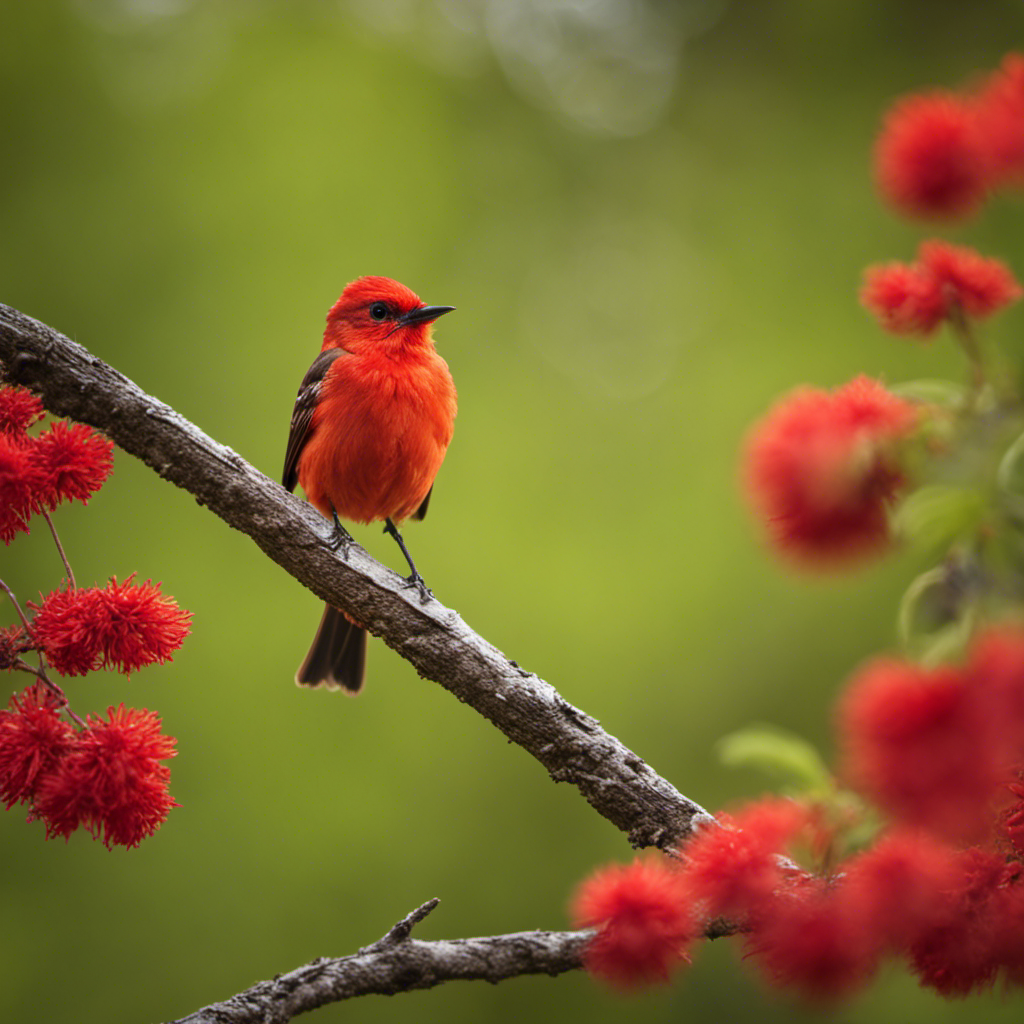
You might spot a flock of around twenty Common Redpolls, with their distinctive red caps, feeding on the seeds of birch trees in the winter.
The Common Redpoll (Acanthis flammea) is a small finch that can be found in the northern regions of North America, including Michigan. Their habitat consists of boreal forests, tundra, and open woodland areas with birch trees, as these provide them with a reliable source of food.
During the winter months, Common Redpolls undertake vertical migration, moving from the far north to more southern areas in search of food.
To attract Common Redpolls to your backyard, consider putting up multiple bird feeders filled with nyjer or sunflower seeds, as these are their preferred food sources. Providing dense shrubs or evergreen trees can also offer them shelter and security.
Vermillion Flycatcher
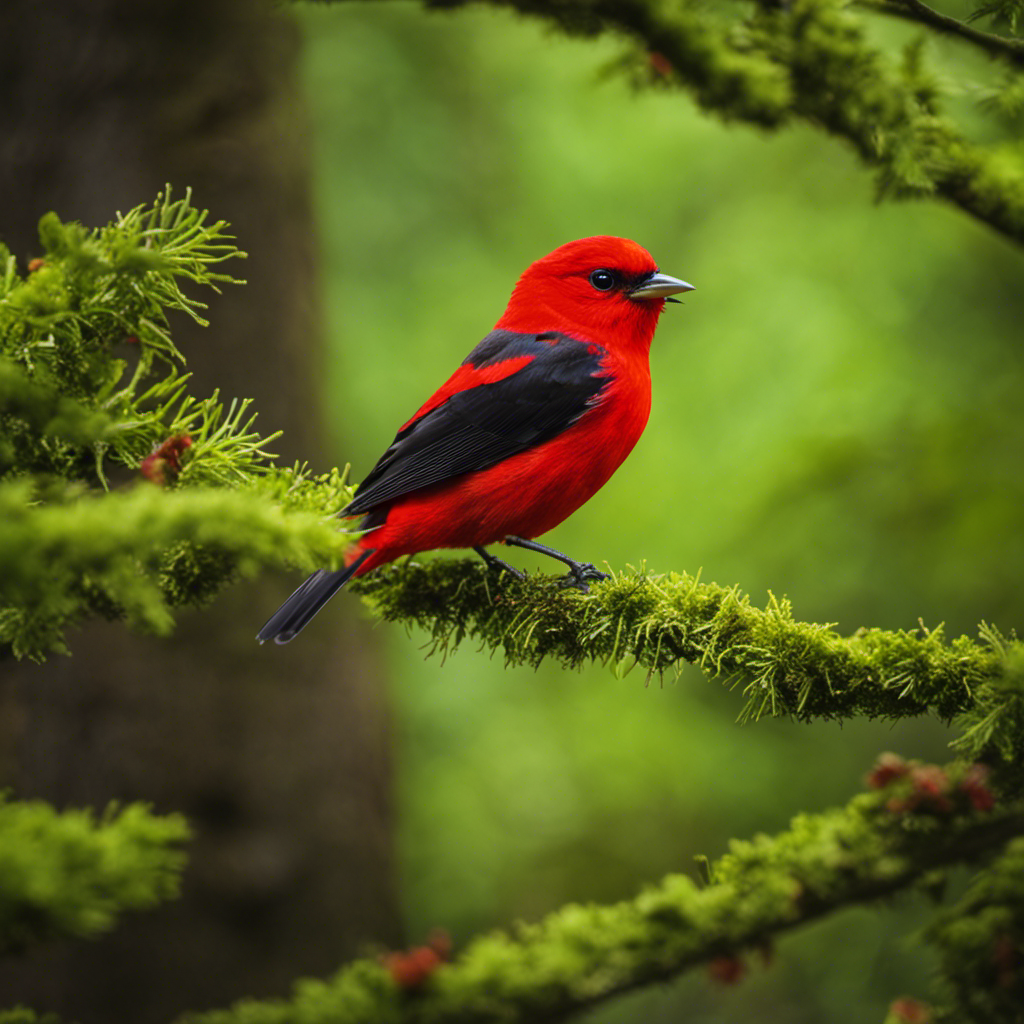
If you’re lucky, you may catch a glimpse of the vibrant Vermillion Flycatcher perched on a branch while it hunts for insects. This stunning bird, with its fiery red plumage and distinctive crest, is known for its remarkable migration patterns and unique breeding habits.
Migration Patterns:
The Vermillion Flycatcher is a neotropical migrant, which means it travels long distances between its breeding grounds and wintering grounds. These birds breed in the southwestern United States and Mexico, and then migrate to Central and South America for the winter. They undertake this arduous journey twice a year, navigating over vast distances to find suitable habitats.Breeding Habits:
During the breeding season, male Vermillion Flycatchers engage in elaborate courtship displays to attract mates. They perch prominently on tree branches, flicking their tails and singing melodious songs to establish territories and attract females. Once a pair forms, they build cup-shaped nests in trees or shrubs, using materials such as twigs, grass, and feathers. The female lays a clutch of 3-4 eggs, which she incubates for about two weeks before they hatch.
Scarlet Tanager
Have you ever seen a Scarlet Tanager perched on a tree branch, singing its beautiful song? These vibrant red birds, scientifically known as Piranga olivacea, are a sight to behold. Scarlet Tanagers are neotropical migrants, meaning they spend their breeding season in North America and then migrate to tropical regions of South America for the winter. Their migration patterns are influenced by various factors such as food availability, weather conditions, and daylight hours. To understand their migration patterns better, let’s take a look at the table below:
| Factors Influencing Migration | Effects on Scarlet Tanager |
|---|---|
| Food Availability | Determines stopover sites |
| Weather Conditions | Affects flight patterns |
| Daylight Hours | Triggers migratory behavior |
Red-headed Woodpecker

Isn’t it amazing how the Red-headed Woodpecker’s bright red crest stands out against its black and white feathers? This stunning bird, known scientifically as Melanerpes erythrocephalus, is a fascinating species found in various parts of North America, including Michigan. Let’s delve into some key aspects of the Red-headed Woodpecker’s habitat and behavior:
Habitat: These woodpeckers prefer open woodlands, including forests, orchards, and parks. They’re commonly found in areas with mature trees that provide suitable nesting cavities.
Behavior: Red-headed Woodpeckers are skilled foragers, mainly feeding on insects, fruits, nuts, and seeds. They’re also known for their unique habit of catching insects mid-air.
Conservation efforts: Due to habitat loss, the Red-headed Woodpecker population has been declining. Conservation efforts focus on preserving their habitats, including the protection of nesting trees and providing artificial nest boxes.
Interesting facts: Did you know that Red-headed Woodpeckers are known to store food in tree crevices or even impale it on thorns for later consumption?
Understanding the habitat, behavior, and conservation efforts of the Red-headed Woodpecker is crucial for ensuring the long-term survival of this beautiful species.
Red-bellied Woodpecker

You can observe the Red-bellied Woodpecker drumming on tree trunks, as it searches for insects and communicates with other woodpeckers.
The Red-bellied Woodpecker, known scientifically as Melanerpes carolinus, is a medium-sized woodpecker that can be found in various habitats across eastern North America, including forests, woodlands, and suburban areas. This species prefers mature forests with a mix of tall trees and open areas, providing them with a diverse food source and suitable nesting sites.
The Red-bellied Woodpecker is known for its distinctive call, which it uses for territorial defense and communication with other members of its species. They also engage in drumming behavior, where they rapidly tap on tree trunks to establish their presence and attract mates.
These behaviors, along with their habitat preferences, contribute to the important ecological role of the Red-bellied Woodpecker in maintaining healthy forest ecosystems.
Red-tailed Hawk

When you spot a Red-tailed Hawk soaring high above, it’s hard not to be in awe of its impressive wingspan and sharp eyesight. This majestic bird is known for its distinct red tail feathers, which give it its name.
The Red-tailed Hawk is a common sight in North America, and its population spans from Alaska to Panama. One of the most fascinating aspects of the Red-tailed Hawk is its migration pattern. Each year, these birds undertake long journeys, traveling hundreds of miles to reach their breeding grounds. They rely on their excellent navigation skills and keen eyesight to find their way.
Understanding the bird migration patterns of the Red-tailed Hawk is crucial for conservation efforts and gaining insights into their behavior.
Red-shouldered Hawk
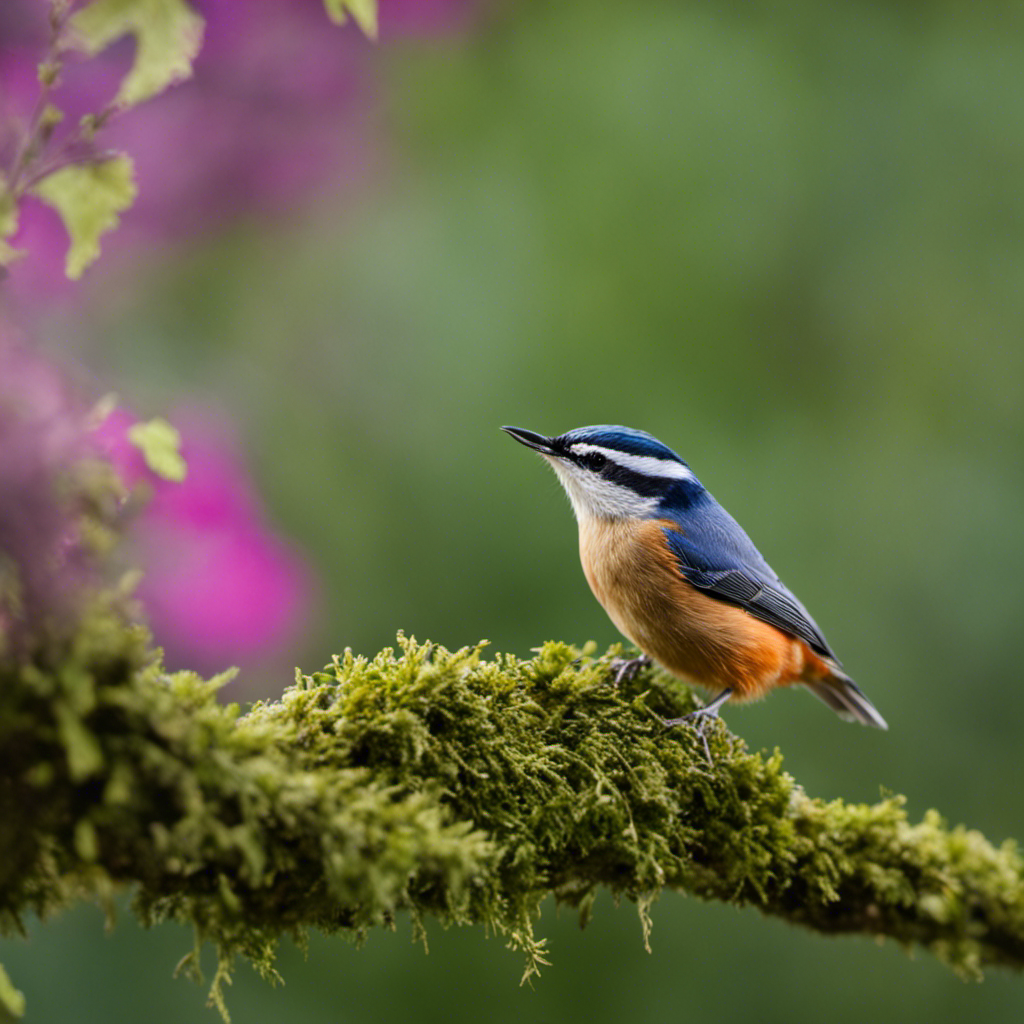
Spotting a Red-shouldered Hawk perched on a tree branch can be an exciting experience, especially when you witness its impressive hunting skills in action. The Red-shouldered Hawk, scientifically known as Buteo lineatus, is a medium-sized bird of prey found in North America. It’s known for its distinctive reddish-brown shoulder patches and beautiful plumage.
When it comes to breeding habits, Red-shouldered Hawks are monogamous and form long-term pair bonds. They usually build large stick nests in the canopy of deciduous trees near water bodies. Breeding season occurs from March to July, with females laying 2-4 eggs.
As for migration patterns, Red-shouldered Hawks are partially migratory birds. Some individuals migrate south during the winter months, while others remain in their breeding territories. It’s fascinating to observe their movements and understand the factors that influence their migration decisions.
Red-breasted Nuthatch
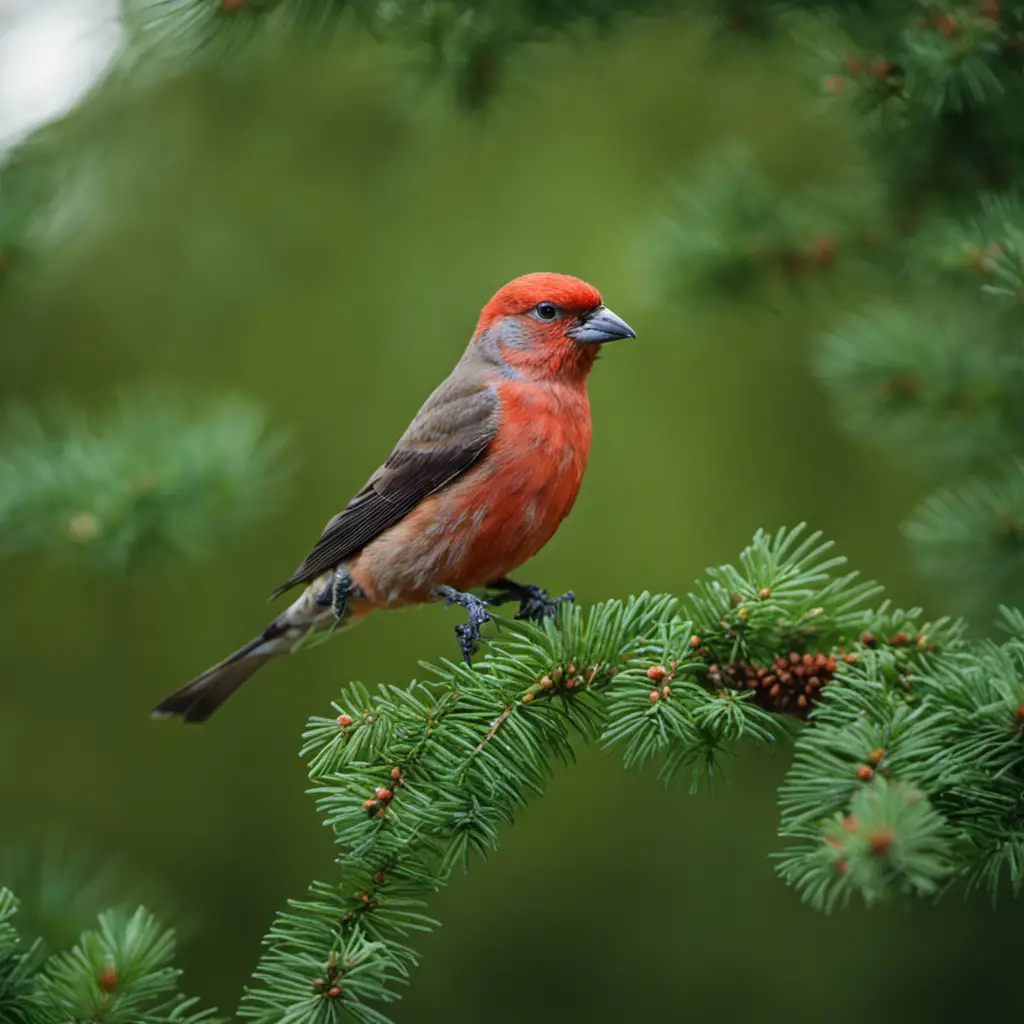
Have you ever heard the distinctive call of a Red-breasted Nuthatch while out in the woods? These small birds, measuring only 4.5 inches in length, are known for their vibrant red breast and distinct vocalizations. Red-breasted Nuthatches are a common sight in North America, particularly in coniferous forests.
Here are some key points about the nesting habits and feeding behavior of Red-breasted Nuthatches:
Nesting Habits:
They typically build their nests in tree cavities, often using old woodpecker holes or natural crevices.
The female nuthatch constructs the nest using a combination of soft materials, such as moss, grass, and bark strips, and lines it with feathers and fur.
They’re known to be cooperative breeders, with multiple individuals helping to raise the young.
Feeding Behavior:
Red-breasted Nuthatches have a unique feeding behavior called ‘hitching,’ where they crawl headfirst down tree trunks in search of insects and seeds.
They’ve a specialized bill that allows them to pry open pine cones and extract seeds.
In addition to insects and seeds, they also feed on sap, particularly during the winter months when other food sources are scarce.
Understanding the nesting habits and feeding behavior of Red-breasted Nuthatches provides valuable insights into their ecology and enables us to better appreciate their role in our forest ecosystems.
Red-eyed Vireo
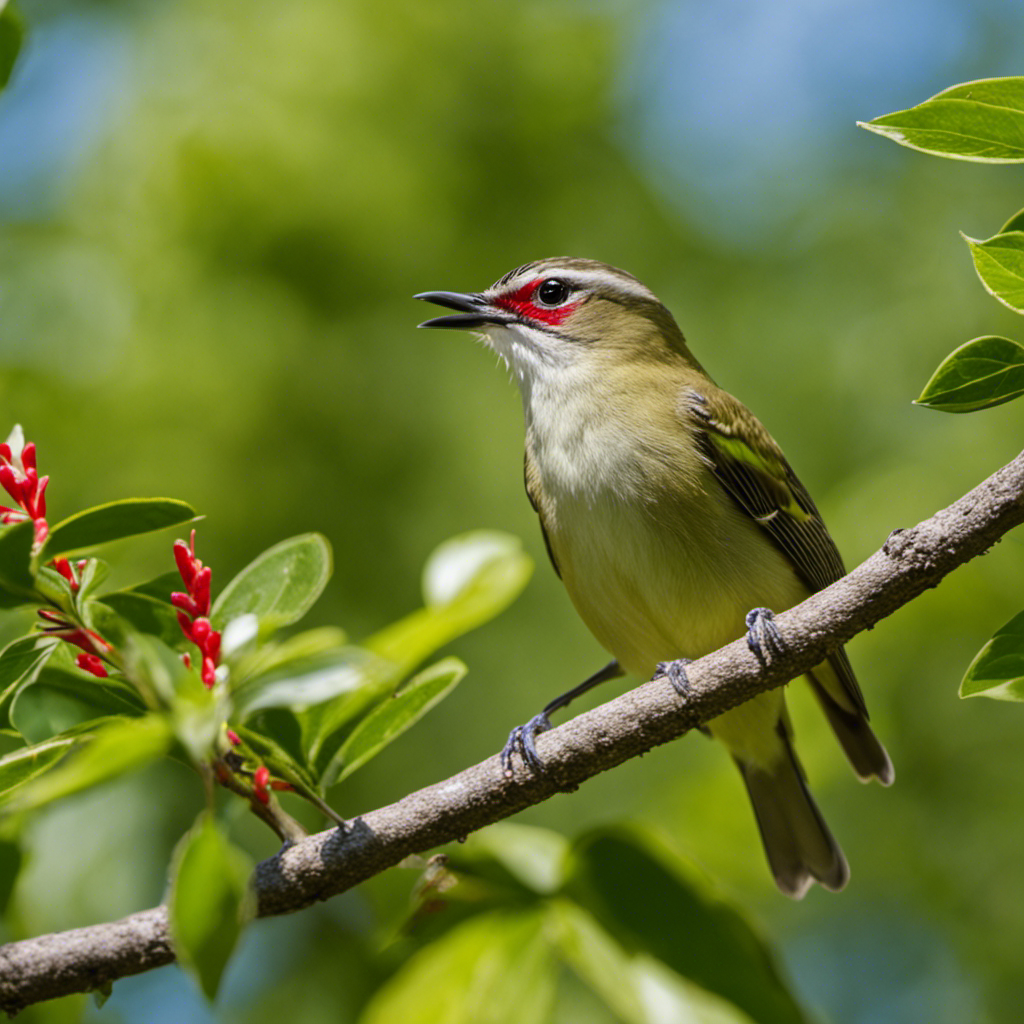
Did you know that the Red-eyed Vireo is commonly found in Michigan and is known for its distinctive red eyes and melodious song? The Red-eyed Vireo, scientifically known as Vireo olivaceus, is a small migratory songbird that belongs to the Vireonidae family.
This species is known for its vibrant red eyes, which contrast with its olive-green plumage. It measures approximately 5.5 to 6 inches in length and has a wingspan of about 9 to 10 inches.
The Red-eyed Vireo is a neotropical migrant, spending its breeding season in Michigan and other parts of North America, and then migrating to Central and South America during the winter months. This remarkable bird has a distinct and melodious song, which it uses to establish territories and communicate with other individuals.
Its migration patterns are governed by factors such as food availability and weather conditions. The Red-eyed Vireo’s migration is a fascinating phenomenon that continues to intrigue scientists and bird enthusiasts alike.
Red-winged Blackbird
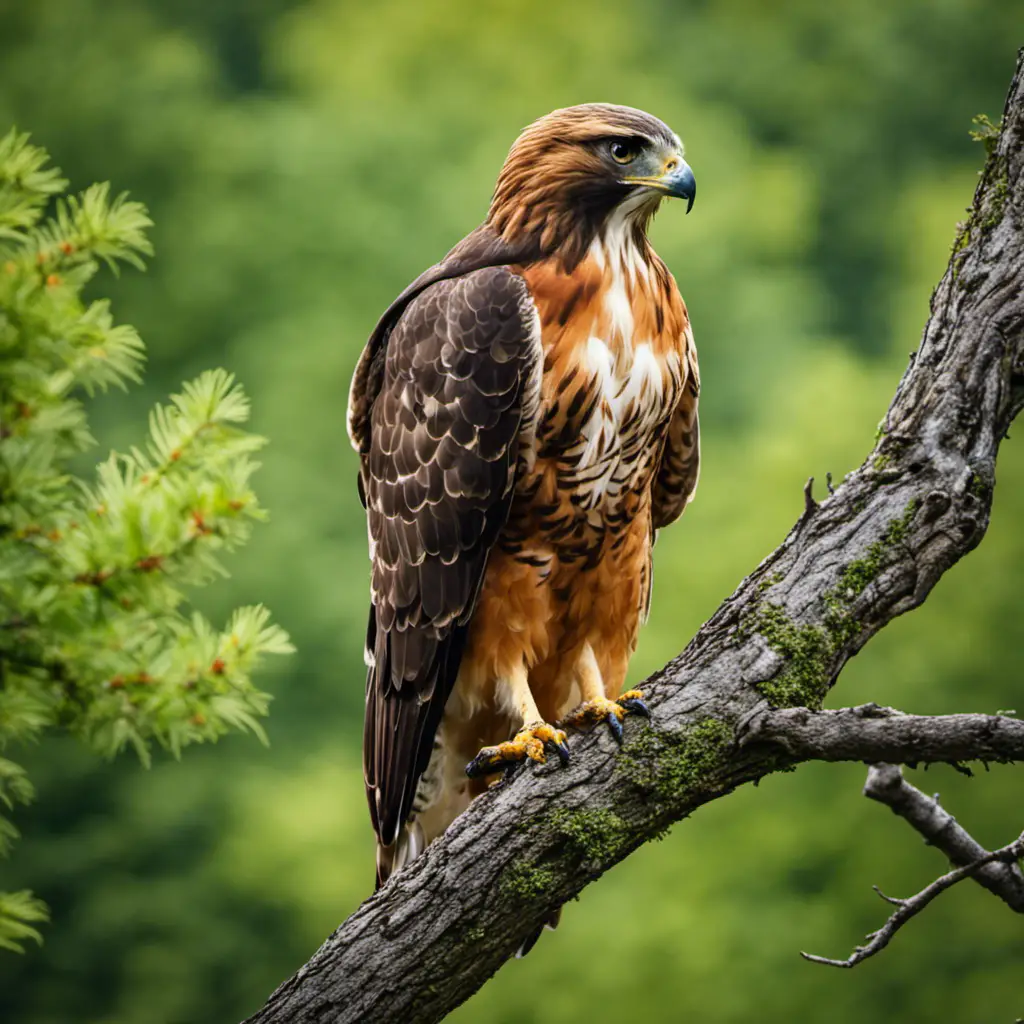
If you look closely, you can spot the vibrant red patches on the wings of the Red-winged Blackbird as it sings its distinctive song. This iconic bird is known for its striking appearance and melodic vocalizations.
Here are some key facts about the Red-winged Blackbird:
- Red-winged Blackbirds are migratory birds that can be found across North America, including Michigan.
- They typically migrate in large flocks, moving south during the winter and returning north in the spring.
- During the nesting season, which typically starts in March, male Red-winged Blackbirds establish territories and attract females by displaying their red wing patches and singing.
- The females build nests in dense vegetation near water, using grasses and other plant material.
- The nests are well-hidden and provide protection for the eggs and chicks.
Understanding the migration patterns and nesting habits of Red-winged Blackbirds is crucial for conservation efforts and maintaining their populations. These birds play a vital role in the ecosystem and bring beauty to our natural surroundings.
Red Crossbill

You might be surprised to learn that the Red Crossbill has a specialized bill that’s crossed at the tips, allowing it to pry open conifer cones and extract the seeds inside. This unique adaptation enables the Red Crossbill to thrive in coniferous forests throughout North America.
They primarily inhabit spruce, pine, and fir forests, where they can find an abundant supply of their main food source, conifer seeds. The bill’s crossed tips act like forceps, allowing the bird to wedge into the cone and extract the seeds.
As for breeding behavior and mating rituals, Red Crossbills are monogamous and form strong pair bonds. They engage in courtship displays, including male birds singing and fluttering their wings to attract females.
Nesting occurs in the branches of conifer trees, where the female lays her eggs and both parents take turns incubating them.
Red Knot
Have you heard about the incredible migration journey that the Red Knot undertakes each year?
These small shorebirds, known for their striking red plumage, embark on an extraordinary journey spanning thousands of miles.
Here are some key facts about the Red Knot’s migration patterns:
Long-distance traveler: The Red Knot travels from its breeding grounds in the Arctic to its wintering grounds in the southern tip of South America, covering a distance of over 9,000 miles.
Critical stopover sites: During their journey, Red Knots rely on specific stopover sites along their route to rest and refuel. These sites, often located along coastal areas, provide vital resources such as food and shelter.
Threats to migration: The Red Knot’s migration patterns are facing numerous threats, including habitat loss, climate change, and disturbance at stopover sites.
Conservation efforts: Conservation organizations are working to protect and restore key habitats along the Red Knot’s migration route, as well as advocating for policies that support the conservation of these remarkable birds.
Understanding the migration patterns of the Red Knot is crucial for developing effective conservation strategies to ensure the survival of this species.
Conservation efforts are essential to safeguarding the Red Knot and preserving the beauty and diversity of our natural world.
Red-necked Grebe
Did you know that the Red-necked Grebe can dive underwater for up to a minute and a half, and then resurface hundreds of meters away?
This fascinating bird, known scientifically as Podiceps grisegena, is native to North America and Europe.
The Red-necked Grebe can be found in a variety of aquatic habitats, including lakes, ponds, and slow-moving rivers. It prefers areas with dense emergent vegetation, as this provides cover and nesting sites.
The behavior of the Red-necked Grebe is equally intriguing. During the breeding season, it performs an elaborate courtship display, consisting of head shaking, wing fluttering, and vocalizations.
It’s a skilled swimmer and diver, using its webbed feet and strong wings to propel itself underwater in search of fish and invertebrates.
The Red-necked Grebe is truly a remarkable species, with its unique diving abilities and fascinating behaviors.
Red-throated Loon
Take a moment to observe the elegant swimming and diving abilities of the Red-throated Loon. This species, scientifically known as Gavia stellata, is an expert at maneuvering through the water with its sleek body and webbed feet.
The Red-throated Loon is known for its long-distance migration patterns, as it travels from its breeding grounds in the Arctic to its wintering grounds along coastal areas. During breeding season, these birds form monogamous pairs and build nests on lakeshores or islands.
The female typically lays one to two eggs, which both parents take turns incubating. Once hatched, the chicks are precocial and able to swim and dive within hours of being born.
The Red-throated Loon’s migration patterns and breeding habits are fascinating aspects of its life cycle, highlighting its adaptability and resilience in different environments.
Red Phalarope
You should definitely pay attention to the Red Phalarope because they are incredibly skilled swimmers and divers. These small, colorful birds can be found in the Arctic regions during the breeding season, but they migrate southward during the winter months. Red Phalaropes have fascinating migration patterns, with some individuals traveling thousands of miles to reach their wintering grounds. During breeding season, they display unique breeding behavior, with the females being more brightly colored than the males. To give you a better understanding, take a look at the table below:
| Migration Patterns | Breeding Behavior |
|---|---|
| Long-distance migration | Colorful females |
| Arctic breeding grounds | Males incubate eggs |
| Wintering grounds in coastal areas | Courtship displays |
| Migratory flocks | Nest on the ground |
As you can see, the Red Phalarope exhibits interesting traits and behaviors that make them a captivating species to study.
Red-billed Tropicbird
There are three different species of tropicbirds, and the Red-billed Tropicbird is one of them. This species is known for its vibrant red bill and long, white tail feathers.
Red-billed Tropicbirds are primarily found in tropical regions, including the Caribbean, the Indian Ocean, and the western Pacific. They’re known for their impressive migration patterns, with some individuals traveling thousands of kilometers each year.
These birds breed in colonies on remote islands, where they build nests on cliffs or in crevices. They lay a single egg, which both parents take turns incubating. After the chick hatches, it’s fed a diet of fish and squid until it’s ready to fledge.
Red-billed Tropicbirds are fascinating creatures, and further research is needed to fully understand their behavior and conservation needs.
Red-footed Booby
Don’t miss out on the fascinating discussion about the Red-footed Booby happening right now!
The Red-footed Booby, scientifically known as Sula sula, is a seabird that’s widely distributed across tropical and subtropical regions.
One of the intriguing aspects of this species is its bird migration patterns. Red-footed Boobies are known to have a complex migratory behavior, with some populations undertaking long-distance migrations while others remain more sedentary.
The migratory routes of Red-footed Boobies vary depending on their breeding locations. For instance, populations breeding in the Pacific Ocean tend to undertake shorter migrations, whereas those breeding in the Caribbean Sea migrate longer distances, sometimes even crossing the equator.
These migration patterns are influenced by factors such as food availability, reproductive cycle, and environmental conditions.
Studying the migration patterns of Red-footed Boobies provides valuable insights into their behavior, ecology, and conservation.
Reddish Egret
There are two subspecies of Reddish Egret, the dark morph and the white morph, and both of them exhibit unique foraging behaviors.
The dark morph Reddish Egret is known for its active feeding behavior, which includes running, jumping, and spinning in the water to scare fish into view.
The white morph Reddish Egret, on the other hand, uses a stealthy approach called ‘canopy feeding.’ It spreads its wings over the water like an umbrella, creating shade that attracts fish.
These feeding behaviors make the Reddish Egret a fascinating species to study and observe in the wild.
Conservation efforts for the Reddish Egret are crucial to ensure the protection of their habitats and the sustainability of their populations.
Understanding the Reddish Egret’s unique feeding behaviors and supporting conservation efforts are important steps toward preserving this remarkable bird for future generations.
Frequently Asked Questions
How Do Red Birds in Michigan Contribute to the Ecosystem?
Red birds in Michigan, through their behavior and diet, contribute to the ecosystem by dispersing seeds, controlling insect populations, and helping with pollination. They play a vital role in maintaining the balance and diversity of the local environment.
What Is the Average Lifespan of Red Birds in Michigan?
The average lifespan of red birds in Michigan varies, but it is typically around 2 to 4 years. Migration patterns play a significant role in their survival, as they travel to warmer climates during winter.
Do Red Birds in Michigan Migrate During Certain Seasons?
Red birds in Michigan exhibit migration patterns. They migrate during certain seasons, displaying specific behavior and habitat preferences. Understanding their migration patterns can provide insight into their population dynamics and ecological interactions.
Are There Any Threats to the Population of Red Birds in Michigan?
There are several threats to the population of red birds in Michigan. One significant threat is the impact of climate change on their habitat, which can affect their breeding patterns and food sources.
Can Red Birds in Michigan Be Found in Urban Areas or Are They Primarily Found in Rural Habitats?
Red birds in Michigan can be found in both urban and rural areas. However, urban sightings are less common due to habitat loss and increased human activity. Red bird conservation efforts aim to protect their habitats and promote population growth.
Conclusion
In conclusion, Michigan is home to a variety of red birds, including the American Robin, Northern Cardinal, Purple Finch, House Finch, Common Redpoll, Red Phalarope, Red-billed Tropicbird, Red-footed Booby, and Reddish Egret.
These bird species can be found throughout the state, showcasing their vibrant red plumage. Their presence adds to the diverse avian population in Michigan and contributes to the rich natural heritage of the region.
Further research and conservation efforts are necessary to ensure the continued thriving of these red birds in Michigan’s ecosystems.

An avid ornithologist, zoologist and biologist with an unwavering passion for birds and wild animals.
Dr. Wilson’s journey in ornithology began in childhood and led him to obtain a Ph.D. in Ornithology from the prestigious Avian Research Institute. He has worked closely with renowned experts in the field and conducted extensive research and field studies globally.

